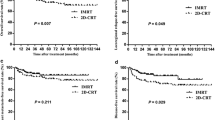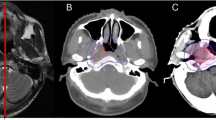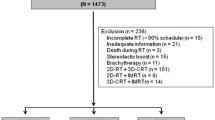Abstract
Purpose
To compare the clinical results and functional outcomes between two-dimensional conventional radiation therapy (2DRT) and intensity-modulated radiation therapy (IMRT) in nasopharyngeal carcinoma (NPC) with skull-base invasion.
Methods
A total of 1258 patients were subclassified into two groups: mild skull-base invasion group (792; 63%) and severe skull-base invasion group (466; 37%). Patients were pair matched (1:1 ratio) using six clinical factors into 2DRT or IMRT groups. The Kaplan–Meier method and Cox regression model were performed to assess overall survival (OS), disease-free survival (DFS), locoregional relapse-free survival (LRRFS) and distant metastasis-free survival (DMFS). Toxicities were evaluated.
Results
IMRT significantly improved four-year OS compared with 2DRT (65.6% vs. 81.8%, P = 0.000), DFS (57.3% vs. 73.3%, P = 0.000) and LRRFS (76.5% vs. 87.5%, P = 0.003) in NPC with severe skull-base invasion, but similar results were observed in patients with mild skull-base invasion (P > 0.05). In patients with severe invasion, radiation therapy techniques were found to be an independent prognostic factor for OS (HR = 0.457, P = 0.000), DFS (HR = 0.547, P = 0.000) and LRRFS (HR = 0.503, P = 0.004). IMRT was associated with better OS. In subgroups analysis, IMRT group also had a better survival in OS, DFS (P < 0.05 for all rates) for patients received concurrent chemotherapy and sequential chemotherapy compared to 2DRT in the severe invasion group. The IMRT group displayed lower incidence of mucositis, xerostomia, trismus (< 1 cm) and temporal lobe necrosis than the 2DRT group.
Conclusions
IMRT significantly improved patient survival compared with 2DRT in NPC patients with severe skull-base invasion, but a similar survival rate was noted in mild invasion patients. Chemotherapy can improve survival in NPC patients with severe invasion. Among the two therapies, IMRT significantly decreased therapy-related toxicity.


Similar content being viewed by others
Abbreviations
- 2DRT:
-
Two-dimensional conventional radiation therapy
- IMRT:
-
Intensity-modulated radiation therapy
- NPC:
-
Nasopharyngeal carcinoma
- OS:
-
Overall survival
- DFS:
-
Disease-free survival
- LRRFS:
-
Locoregional relapse-free survival
- DFMS:
-
Distant metastasis-free survival
- RT:
-
Radiation therapy
- PTV:
-
Planning target volume
- GTVnx:
-
Gross tumor volume of the primary
- GTVnd:
-
Nodal gross tumor volume
- IC:
-
Induction chemotherapy
- CCRT:
-
Concurrent chemoradiotherapy
- AC:
-
Adjuvant chemotherapy
- HR:
-
Hazard ratios
- RECIST:
-
Response evaluation criteria in solid tumors
- CR:
-
Complete remission
References
Cao C, Jiang F, Jin Q et al (2018) Locoregional extension and patterns of failure for nasopharyngeal carcinoma with intracranial extension. Oral Oncol 79:27–32
Carman J, Strojan P (2012) Nasopharyngeal carcinoma in Slovenia, 1990–2003 (results of treatment with conventional two-dimensional radiotherapy). Rep Pract Oncol Radiother 17(2):71–78
Chau RM, Teo PM, Choi PH et al (2001) Three-dimensional dosimetric evaluation of a conventional radiotherapy technique for treatment of nasopharyngeal carcinoma. Radiother Oncol 58(2):143–153
Chen L, Liu LZ, Mao YP et al (2011) Grading of MRI-detected skull-base invasion in nasopharyngeal carcinoma and its prognostic value. Head Neck 33(9):1309–1314
Chen JL, Huang YS, Kuo SH et al (2013) Intensity-modulated radiation therapy for T4 nasopharyngeal carcinoma. Treatment results and locoregional recurrence. Strahlenther Onkol 189(12):1001–1008
Chen L, Zhang Y, Lai SZ et al (2019) 10-Year results of therapeutic ratio by intensity-modulated radiotherapy versus two-dimensional radiotherapy in patients with nasopharyngeal carcinoma. Oncologist 24(1):e38–e45
Heng DM, Wee J, Fong KW et al (1999) Prognostic factors in 677 patients in Singapore with nondisseminated nasopharyngeal carcinoma. Cancer 86(10):1912–1920
Hsiung CY, Wu JM, Wang CJ et al (2001) Attenuation of radiation dose by the skull base bone in patients with nasopharyngeal carcinoma: clinical importance. Radiology 218(2):457–463
Huang TL, Chien CY, Tsai WL et al (2016) Long-term late toxicities and quality of life for survivors of nasopharyngeal carcinoma treated with intensity-modulated radiotherapy versus non-intensity-modulated radiotherapy. Head Neck 38(Suppl 1):E1026–1032
Hui EP, Ma BB, Leung SF et al (2009) Randomized phase II trial of concurrent cisplatin-radiotherapy with or without neoadjuvant docetaxel and cisplatin in advanced nasopharyngeal carcinoma. J Clin Oncol 27(2):242–249
Kam MK, Chau RM, Suen J et al (2003) Intensity-modulated radiotherapy in nasopharyngeal carcinoma: dosimetric advantage over conventional plans and feasibility of dose escalation. Int J Radiat Oncol Biol Phys 56(1):145–157
Lee AW, Tung SY, Chua DT et al (2010) Randomized trial of radiotherapy plus concurrent-adjuvant chemotherapy vs radiotherapy alone for regionally advanced nasopharyngeal carcinoma. J Natl Cancer Ins 102(15):1188–1198
Lee AW, Ma BB, Ng WT et al (2015) Management of nasopharyngeal carcinoma: current practice and future perspective. J Clin Oncol 33(29):3356–3364
Lee AZE, Tan LSY, Lim CM (2018) Cellular-based immunotherapy in Epstein-Barr virus induced nasopharyngeal cancer. Oral Oncol 84:61–70
Leong SS, Wee J, Tay MH et al (2005) Paclitaxel, carboplatin, and gemcitabine in metastatic nasopharyngeal carcinoma: a Phase II trial using a triplet combination. Cancer 103(3):569–575
Lin J, Lv X, Niu M, Liu L et al (2017) Radiation-induced abnormal cortical thickness in patients with nasopharyngeal carcinoma after radiotherapy. Neuroimage Clin 14:610–621
Lu TX, Mai WY, Teh BS et al (2001) Important prognostic factors in patients with skull base erosion from nasopharyngeal carcinoma after radiotherapy. Int J Radiat Oncol Biol Phys 51(3):589–598
Lu TX, Mai WY, Teh BS et al (2004) Initial experience using intensity-modulated radiotherapy for recurrent nasopharyngeal carcinoma. Int J Radiat Oncol Biol Phys 58(3):682–687
Nakanishi Y, Wakisaka N, Kondo S et al (2017) Progression of understanding for the role of Epstein-Barr virus and management of nasopharyngeal carcinoma. Cancer Metastasis Rev 36(3):435–447
Peng G, Wang T, Yang KY et al (2012) A prospective, randomized study comparing outcomes and toxicities of intensity-modulated radiotherapy vs. conventional two-dimensional radiotherapy for the treatment of nasopharyngeal carcinoma. Radiother Oncol 104(3):286–293
Peng H, Chen L, Li WF et al (2017) Tumor response to neoadjuvant chemotherapy predicts long-term survival outcomes in patients with locoregionally advanced nasopharyngeal carcinoma: a secondary analysis of a randomized phase 3 clinical trial. Cancer 123(9):1643–1652
Peng YL, Chen L, Shen GZ et al (2018) Interobserver variations in the delineation of target volumes and organs at risk and their impact on dose distribution in intensity-modulated radiation therapy for nasopharyngeal carcinoma. Oral Oncol 82:1–7
Rodríguez-Caballero A, Torres-Lagares D, Robles-García M et al (2012) Cancer treatment-induced oral mucositis: a critical review. Int J Oral Maxillofac Surg 41(2):225–238
Rotolo F, Pignon JP, Bourhis J et al (2017) Surrogate end points for overall survival in loco-regionally advanced nasopharyngeal carcinoma: an individual patient data meta-analysis. J Natl Cancer Inst 109(4):1–9
Sun X, Su S, Chen C et al (2014) Long-term outcomes of intensity-modulated radiotherapy for 868 patients with nasopharyngeal carcinoma: an analysis of survival and treatment toxicities. Radiother Oncol 110(3):398–403
Sun Y, Li W-F, Chen N-Y et al (2016) Induction chemotherapy plus concurrent chemoradiotherapy versus concurrent chemoradiotherapy alone in locoregionally advanced nasopharyngeal carcinoma: a phase 3, multicentre, randomised controlled trial. Lancet Oncol 17(11):1509–1520
Tang LQ, Li CF, Li J et al (2016) Establishment and Validation of Prognostic Nomograms for Endemic Nasopharyngeal Carcinoma. J Natl Cancer Inst 108(1):1–10
Teo P, Yu P, Lee WY et al (1996) Significant prognosticators after primary radiotherapy in 903 nondisseminated nasopharyngeal carcinoma evaluated by computer tomography. Int J Radiat Oncol Biol Phys 36(2):291–304
Twu CW, Wang WY, Chen CC et al (2014) Metronomic adjuvant chemotherapy improves treatment outcome in nasopharyngeal carcinoma patients with postradiation persistently detectable plasma Epstein-Barr virus deoxyribonucleic acid. Int J Radiat Oncol Biol Phys 89(1):21–29
Uzel EK, Karaçam S, Eliçin O et al (2013) Comparison of two different IMRT planning techniques in the treatment of nasopharyngeal carcinoma. Effect on parotid gland radiation doses. Strahlenther Onkol 189(7):552–558
Wang SY, Xu XW, Yao JJ et al (2018) A retrospective dosimetry study of intensity-modulated radiotherapy for nasopharyngeal carcinoma: radiation-induced brainstem injury and dose-volume analysis. Radiat Oncol 13(1):194
Yao CY, Zhou GR, Wang LJ et al (2018) A retrospective dosimetry study of intensity-modulated radiotherapy for nasopharyngeal carcinoma: radiation-induced brainstem injury and dose-volume analysis. Radiation oncology (London, England) 13(1):194
Yi W, Liu ZG, Li X et al (2016) CT-diagnosed severe skull base bone destruction predicts distant bone metastasis in early N-stage nasopharyngeal carcinoma. Onco Targets Ther 9:7011–7017
Zhang LN, Gao YH, Lan XW et al (2015) Effect of taxanes-based induction chemotherapy in locoregionally advanced nasopharyngeal carcinoma: a large scale propensity-matched study. Oral Oncol 51(10):950–956
Zhang B, Tian J, Dong D et al (2017) Radiomics features of multiparametric MRI as novel prognostic factors in advanced nasopharyngeal carcinoma. Clin Cancer Res 23(15):4259–4269
Zheng Y, Han F, Xiao W et al (2015) Analysis of late toxicity in nasopharyngeal carcinoma patients treated with intensity modulated radiation therapy. Radiat Oncol 10:17
Funding
This work was supported by the National Natural Science Foundation of China (Nos. 81560443, 81760546) and the Scientific Research and Technology Development Program of Guilin (No. 20170109-22), the Key Program of the Guangxi Natural Science Foundation of China (No. 2018JJD140054), the General Program of Guangxi Natural Science Foundation of China (No. 2018GXNSFAA138100).
Author information
Authors and Affiliations
Contributions
Study concept and design: SFL and WJ. Data acquisition and analysis: SFL, YX, YF, YYZ and WJ. Data interpretation: all authors. Drafting the manuscript: SFL and WJ. Critical revision of the manuscript for important intellectual content: all authors. Supervision: WJ. All authors read and approved the final manuscript.
Corresponding author
Ethics declarations
Conflict of interest
The authors declare that they have no conflict of interest.
Ethical approval
The study was approved by the Medical Ethics Committee of affiliated Hospital of Guilin Medical University, Wuzhou Red Cross Hospital, and Nanxishan Hospital of Guangxi Zhuang Autonomous Region.
Informed consent
Informed consent was obtained from all individual participants included in the study.
Additional information
Publisher's Note
Springer Nature remains neutral with regard to jurisdictional claims in published maps and institutional affiliations.
Electronic supplementary material
Below is the link to the electronic supplementary material.
Rights and permissions
About this article
Cite this article
Liao, S., Xie, Y., Feng, Y. et al. Superiority of intensity-modulated radiation therapy in nasopharyngeal carcinoma with skull-base invasion. J Cancer Res Clin Oncol 146, 429–439 (2020). https://doi.org/10.1007/s00432-019-03067-y
Received:
Accepted:
Published:
Issue Date:
DOI: https://doi.org/10.1007/s00432-019-03067-y




